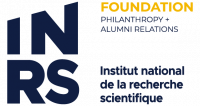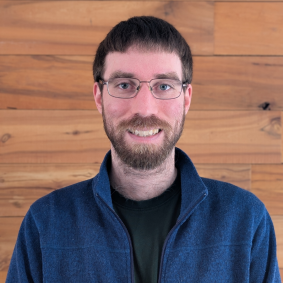Maxime Rivard
PhD in Energy and Materials Sciences (2016)
Researcher, NRC
“The baccalaureate gave me a theoretical grounding, but it was at INRS that I learned to identify the next steps in a research project myself, to build a story around the science we do.”
From the fabrication of nanoparticles to the measurement of innovative optical signals, via collaboration with major research centers, Maxime Rivard has shaped a scientific career marked by rigor and intuition. He was able to transform a development project into a major breakthrough in non-linear optical microscopy, before continuing his career at NRC, where he combines fundamental research with applied innovation.
His master's project, carried out under the co-direction of Professors My Ali El Khakani and François Légaré, focused on the fabrication of metal nanoparticles capable of sustaining surface plasmons, localized oscillations of the electric field on the surface of metals. The aim was to use the electric field amplification associated with plasmons to enhance the signal in non-linear optical microscopy, a technique that takes particular advantage of amplified field phenomena, with signals proportional to the square or cube of the electric field. Professor El Khakani's laboratory provided expertise in nanoparticle fabrication, while Professor Légaré's laboratory specialized in non-linear optical microscopy.
The project soon took a new turn. Although Maxime had succeeded in fabricating the metal nanoparticles, their properties did not allow them to amplify the electric field sufficiently for the intended microscopy applications. However, working with François Légaré, a new idea emerged: to explore the phase of the signal generated in non-linear optical microscopy, a dimension little studied until then, but potentially rich in information. This unexpected turn of events marked the beginning of his PhD.
“We realized that the signal phase could contain information about the orientation of molecules in tissues. This was new and not really explored at the time,” he explains. Despite the technical challenges, Maxime and his team succeeded in measuring this phase and linking it to molecular orientation in the images obtained. The results, obtained between late 2012 and early 2013, were presented at more than six conferences in the same year.
This project was not only a success, but also paved the way for a whole line of subsequent work. Several researchers took up the torch after him, perfecting the technique, reducing image capture time by a factor of 10,000 and improving the signal by a factor of 100. “This is one of the things I'm most proud of. It's extremely gratifying to see my work being used by others and pushed further,” he confides.
Alongside his research work, Maxime also enjoyed the collaborative atmosphere of the Centre Énergie Matériaux Télécommunications in Varennes. He remembers the summer barbecues, the spontaneous discussions in the cafeteria, and the evenings when experiments continued late in the laboratories. “It's a fairly small center, so you get to know everyone. It's a very human, very pleasant environment,” he recalls.
Since 2016, Maxime has been pursuing his career as a researcher at the National Research Council of Canada (NRC). He works on a wide variety of projects, mainly employing Optical Coherence Tomography imaging technology, ranging from industrial collaborations with companies such as Fives Lund, Rolls-Royce Canada, AV&R to government or university projects, notably with researchers from Polytechnique.
He explains that his time at INRS enabled him to become an independent researcher. “The baccalaureate gave me a theoretical grounding, but it was at INRS that I learned to identify the next steps in a research project myself, to build a story around the science we do,” he says. This ability to build a coherent project, to tell the story of a research project from its conception to its results, is at the heart of his work today, whether he's putting together a grant application, obtaining approval for a project or disseminating it.
For those following in his footsteps, Maxime advises you to store carefully for the project and the person you want to work with. And what about the future? He hopes to see his team grow, continue to work on relevant projects, and find some time to advance his own more fundamental research ideas. “Often, you have a technology that works, and then you go for the application. But I'd also like to take the time to improve this technology, to push it further.”
[Interviewed in march 2025.]

